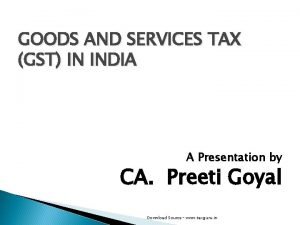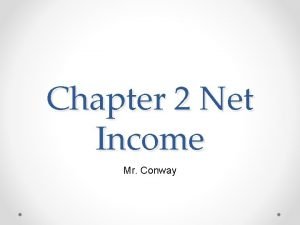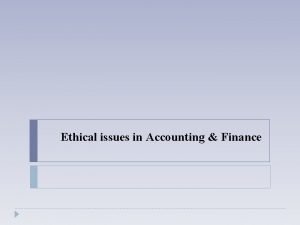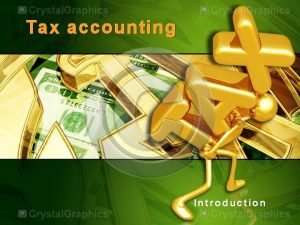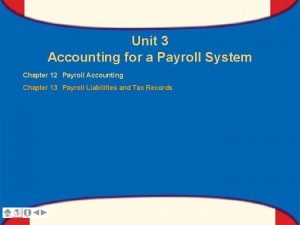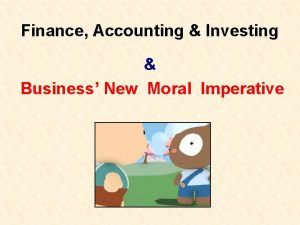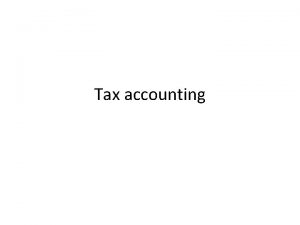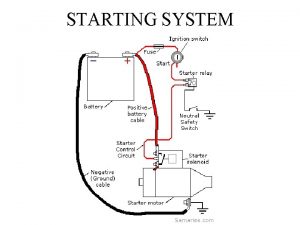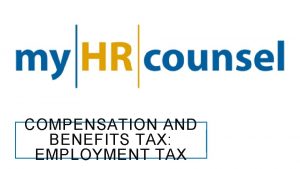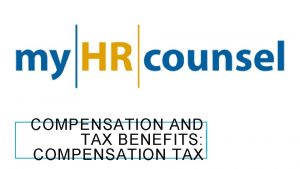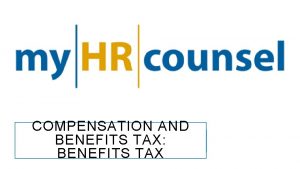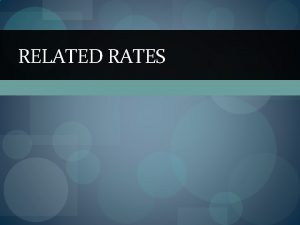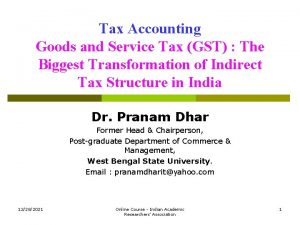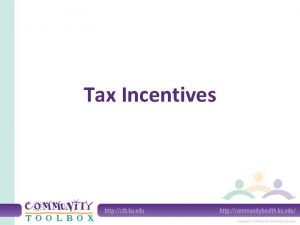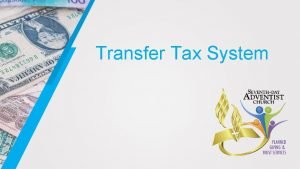ACCOUNTING AND TAX ISSUES RELATED TO STARTING YOUR














- Slides: 14

ACCOUNTING AND TAX ISSUES RELATED TO STARTING YOUR OWN CONSULTING FIRM Harold F. Ingersoll, CPA/ABV/CFF, CVA, CM&AA

1. CHOOSING THE CORRECT LEGAL ENTITY FOR EFFICIENT TAX TREATMENT A. Tax entities – There are pros and cons for each of the different tax structures. C Corporation – 1120 ii. S Corporation – 1120 S iii. Partnership (LP, GP) – 1065 iv. LLC – Not a taxable entity. Elections can be made to be taxed as any of the above. May also be reported on the 1040 as a proprietorship. i.

1. CHOOSING THE CORRECT LEGAL ENTITY FOR EFFICIENT TAX TREATMENT (cont…) C. C Corporation Pros i. 1. 2. 3. 4. § 1045 – Rollover of Gain (Holding period 6 months). § 1202 – Exclusion of Gains (Holding period 5 years). Treatment of employee benefits for owners is simplified. Availability for multiple classes of stock. Cons ii. 1. Double taxation.

1. CHOOSING THE CORRECT LEGAL ENTITY FOR EFFICIENT TAX TREATMENT(cont…) D. S Corporation Pros i. 1. 2. 3. 4. Single level of taxation. Income flows through to the owners and is taxed on their respective returns. Owners can be employees. No self-employment tax on profits. Cons ii. 1. 2. 3. 4. Some employee benefits of the owners may be nondeductible. Can only have voting and non-voting stock. No special allocations allowed. Limitations on number of owners and who can be an owner.

1. CHOOSING THE CORRECT LEGAL ENTITY FOR EFFICIENT TAX TREATMENT(cont…) E. Partnership – Limited Partnership Pros i. 1. 2. 3. 4. Income flows through to the owners and is taxed on their respective returns. Flow through income to limited partners is exempt from self employment tax. Disproportionate distributions and allocations are allowed. Can have different levels of ownership and allocations, such as income partners. Cons ii. 1. 2. 3. Owners cannot be employees. Requires a separate general partner. More complicated.

1. CHOOSING THE CORRECT LEGAL ENTITY FOR EFFICIENT TAX TREATMENT(cont…) F. Partnership – Limited Liability Company Pros i. 1. 2. 3. 4. 5. Income flows through to the owners and is taxed on their respective returns. Does not require a general partner. Simpler than a limited partnership. Disproportionate distributions and allocations are allowed. Different levels of ownership and allocations are allowed. Cons ii. 1. 2. 3. All flow through income may be subject to self employment tax. Owners cannot be employees. Some employee benefits for the owners may not be deductible.

2. TAX OBLIGATIONS A. Federal income taxes B. State income taxes C. State sales taxes D. Payroll taxes i. Income tax withholding ii. FICA withholding iii. State unemployment iv. Federal unemployment v. Additional state payroll tax withholding requirements (depending on the employees are located)

3. PAYING TAXES TIMELY DO YOU KNOW ALL OF THE DEADLINES FOR PAYING ALL OF THE TAXES DISCUSSED EARLIER? A. Quarterly estimates B. Payroll tax deposits C. Payroll taxes in general

4. OTHER ISSUES A. Be careful of transactions that trigger phantom B. C. D. E. income. Accounting system Being sure to keep up with the accounting. Knowing what documentation to keep. Don’t try to do everything yourself.

5. AVOID BLENDING PERSONAL AND BUSINESS FINANCIAL RECORDS A. Must have business finances separated from personal finances. B. Separate checking accounts. C. Separate credit cards. D. Paying personal bills/expenses from business checking account or with business credit card.

6. DEDUCTING BUSINESS EXPENSES Knowing what is deductible and how it is deductible. A. Meals (100% or 50%). B. Fixed asset purchases (Section 179, Bonus depreciation). C. Start up costs (Write off or capitalize).

Many on efd DISCLAIMER significant legal impact in addition to income tax impact. We are not attorneys and any discussion of liability or legal structure issues need to be discussed with an attorney prior to decision making.

QUESTIONS?

CONTACT INFORMATION Atchley & Associates, LLP 1005 La Posada Drive Austin, TX 78752 512 -346 -2086 www. atchleycpas. com Harold F. Ingersoll, CPA/ABV/CFF, CVA, CM&AA hingersoll@atchleycpas. com
 Two type of physical fitness
Two type of physical fitness Skill health related fitness
Skill health related fitness Gst conclusion
Gst conclusion Ralphs annual income is about $32 000
Ralphs annual income is about $32 000 Bioethical issues related to biosafety
Bioethical issues related to biosafety Issues or problems related to local governance/autonomy
Issues or problems related to local governance/autonomy Ethical issues in accounting and finance
Ethical issues in accounting and finance Implementing strategies marketing finance/accounting
Implementing strategies marketing finance/accounting Tax accounting definition
Tax accounting definition Glencoe accounting chapter 13
Glencoe accounting chapter 13 Ethical issues in accounting
Ethical issues in accounting Social issues in accounting
Social issues in accounting Give us your hungry your tired your poor
Give us your hungry your tired your poor Financial accounting chapter 1
Financial accounting chapter 1 Chapter 4 performing basic maneuvers page 14
Chapter 4 performing basic maneuvers page 14


